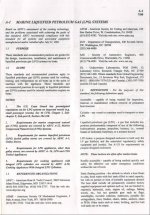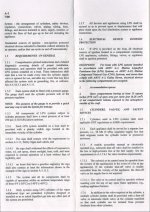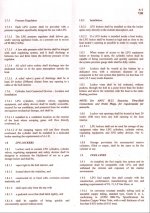You are using an out of date browser. It may not display this or other websites correctly.
You should upgrade or use an alternative browser.
You should upgrade or use an alternative browser.
ABYC Propane Standards
- Thread starter Larry H
- Start date
journey on
New member
- Joined
- Mar 3, 2005
- Messages
- 3,599
- Reaction score
- 0
- C Dory Year
- 2005
- C Dory Model
- 25 Cruiser
- Hull Identification Number
- TBD
- Vessel Name
- journey on
Well, if you're looking for a comment, here's a couple.
First, it says that each appliance shall be serviced by a separate low pressure supply line from the locker to the appliance. Next, that the line shall be a continuous length starting from the regulator, shut off valve, or leak detector. Also, you have to have a shut off valve which can be operated from near the (each) appliance.
I guess this means that you can't manifold off a single regulator/shut off valve/ leak detector. I would guess that a dedicated shut off valve with a switch near the appliance would make the most sense (to me, at least.)
Also, Appendix A shows why we use propane. Less heat per gallon, but butane freezes a 32 deg F (as does water) and propane at -44 deg F. So I don't have to worry about that propane tank sitting outside freezing, just blowing up. And it does vent in the summer.
Boris
First, it says that each appliance shall be serviced by a separate low pressure supply line from the locker to the appliance. Next, that the line shall be a continuous length starting from the regulator, shut off valve, or leak detector. Also, you have to have a shut off valve which can be operated from near the (each) appliance.
I guess this means that you can't manifold off a single regulator/shut off valve/ leak detector. I would guess that a dedicated shut off valve with a switch near the appliance would make the most sense (to me, at least.)
Also, Appendix A shows why we use propane. Less heat per gallon, but butane freezes a 32 deg F (as does water) and propane at -44 deg F. So I don't have to worry about that propane tank sitting outside freezing, just blowing up. And it does vent in the summer.
Boris
Larry H
New member
- Joined
- Nov 1, 2003
- Messages
- 2,041
- Reaction score
- 0
- C Dory Year
- 1991
- C Dory Model
- 22 Cruiser
Boris,
My propane system has a single switch to shut off the solenoid valve. The valve is located in the locker, after the regulator, and before a tee and two single-length hoses which go from there out of the locker. One goes to the propane stove and the other to the propane heater. The switch is above and to one side of the stove and within 4 feet of the heater. (My boat is not a C-Dory).
Since the switch is in the same compartment as both the stove and heater, I consider it adequate. The switch plate has a red LED pilot light which is visible from most of the cabin. I am diligent in ensuring that the appliance not in use is off before lighting the other.
If the two appliances are in different compartments, then two solenoid valves and switches, each controlling one hose would be proper.
Remember these regs are not laws, and are not enforced by the USCG for pleasure boats. The USCG could cite someone for an obviously unsafe installation, but the only enforcement I see likely is a surveyor or insurance company, who might require ABYC compliance.
My propane system has a single switch to shut off the solenoid valve. The valve is located in the locker, after the regulator, and before a tee and two single-length hoses which go from there out of the locker. One goes to the propane stove and the other to the propane heater. The switch is above and to one side of the stove and within 4 feet of the heater. (My boat is not a C-Dory).
Since the switch is in the same compartment as both the stove and heater, I consider it adequate. The switch plate has a red LED pilot light which is visible from most of the cabin. I am diligent in ensuring that the appliance not in use is off before lighting the other.
If the two appliances are in different compartments, then two solenoid valves and switches, each controlling one hose would be proper.
Remember these regs are not laws, and are not enforced by the USCG for pleasure boats. The USCG could cite someone for an obviously unsafe installation, but the only enforcement I see likely is a surveyor or insurance company, who might require ABYC compliance.
journey on
New member
- Joined
- Mar 3, 2005
- Messages
- 3,599
- Reaction score
- 0
- C Dory Year
- 2005
- C Dory Model
- 25 Cruiser
- Hull Identification Number
- TBD
- Vessel Name
- journey on
Sounds good to me. I was only commenting on my interpretation of the ABYC regulations, of which there were some questions in a separate topic.
Boris
Boris
SEA3PO
New member
- Joined
- Nov 2, 2003
- Messages
- 1,835
- Reaction score
- 0
- C Dory Year
- 2003
- C Dory Model
- 22 Cruiser
- Hull Identification Number
- CDO22132D303
- Vessel Name
- SEA3PO
Larry...Thanks for posting this.... I have been checking, and you are right....my solenoid is in the wrong place...even the surveyor did not notice... it is on the low pressure side of the regulator....
Last night I found a proper designed system for multiple outlets... it starts from the tank then the solenoid....then has a "T" to two ball type on off valves followed by a regulator and then line.... so it has two regulators in the system...one for each line....two manual valves...and one solenoid..... all inside the propane locker...each with a watert tight thru hull for each line...
I now have some re-plumbing to do...but it will be right...
Joel
SEA3PO
Last night I found a proper designed system for multiple outlets... it starts from the tank then the solenoid....then has a "T" to two ball type on off valves followed by a regulator and then line.... so it has two regulators in the system...one for each line....two manual valves...and one solenoid..... all inside the propane locker...each with a watert tight thru hull for each line...
I now have some re-plumbing to do...but it will be right...
Joel
SEA3PO
A
Anonymous
Guest
Yeah, what Joel said...
Thanks for posting this, Larry. I'm still in the thick of figuring out my 'new' boat systems and this helps fill in some blanks and corroborate some other sources of info.
T
Thanks for posting this, Larry. I'm still in the thick of figuring out my 'new' boat systems and this helps fill in some blanks and corroborate some other sources of info.
T
SEA3PO
New member
- Joined
- Nov 2, 2003
- Messages
- 1,835
- Reaction score
- 0
- C Dory Year
- 2003
- C Dory Model
- 22 Cruiser
- Hull Identification Number
- CDO22132D303
- Vessel Name
- SEA3PO
Now I really have a problem...... I followed the directions that came with the stove exactally.....and installed the solenoid on the high pressure side of the regulator... just like in the drawing that came with the heater...
It has a diagram of how to hook up two lines, ONLY PROBLEM IS NO MARINE CATALOG SELLS A HIGH PRESSURE SOLENOID VALVE...and it sure will not work using my existing low pressure valve...I tried that...
From the tank...I have the feed line to the solenoid valve then the pressure gauge then it has a "T" to two regulators, then ball valves and then separate lines through separate thru-hulls... just as they have it pictured.... if I just could find a high pressure 12 volt solenoid valve..
Ideas ?
Thanks
Joel
SEA3PO
It has a diagram of how to hook up two lines, ONLY PROBLEM IS NO MARINE CATALOG SELLS A HIGH PRESSURE SOLENOID VALVE...and it sure will not work using my existing low pressure valve...I tried that...
From the tank...I have the feed line to the solenoid valve then the pressure gauge then it has a "T" to two regulators, then ball valves and then separate lines through separate thru-hulls... just as they have it pictured.... if I just could find a high pressure 12 volt solenoid valve..
Ideas ?
Thanks
Joel
SEA3PO
rogerbum
Active member
- Joined
- Nov 21, 2004
- Messages
- 5,934
- Reaction score
- 0
- C Dory Year
- 2008
- C Dory Model
- 255 Tomcat
- Vessel Name
- Meant to be
SEA3PO":2beoj6ow said:Now I really have a problem...... I followed the directions that came with the stove exactally.....and installed the solenoid on the high pressure side of the regulator... just like in the drawing that came with the heater...
It has a diagram of how to hook up two lines, ONLY PROBLEM IS NO MARINE CATALOG SELLS A HIGH PRESSURE SOLENOID VALVE...and it sure will not work using my existing low pressure valve...I tried that...
From the tank...I have the feed line to the solenoid valve then the pressure gauge then it has a "T" to two regulators, then ball valves and then separate lines through separate thru-hulls... just as they have it pictured.... if I just could find a high pressure 12 volt solenoid valve..
Ideas ?
Thanks
Joel
SEA3PO
There's got to be some industrial suppliers that make 12V high pressure solenoid valves in brass or stainless.
Here's one link (pricey) to a valve good to 1000psi. Mc Master Carr might carry something that would work. I've found all kinds of useful things from them.
- Joined
- Oct 23, 2003
- Messages
- 5,342
- Reaction score
- 16
Did you try the Google?? I found a few of 'em.
Here's a dandy for $55.

Or you can go down to your local Hyster wrecking yard.
Here's a dandy for $55.

Or you can go down to your local Hyster wrecking yard.
Larry H
New member
- Joined
- Nov 1, 2003
- Messages
- 2,041
- Reaction score
- 0
- C Dory Year
- 1991
- C Dory Model
- 22 Cruiser
Joel,
My leak down valve shows between 80 and 120 lbs pressure on the high pressure side of the regulator.
I think propane systems are rated to operate under 300lbs.
Pressure can vary with the blend of propane and the ambient temperature.
My leak down valve shows between 80 and 120 lbs pressure on the high pressure side of the regulator.
I think propane systems are rated to operate under 300lbs.
Pressure can vary with the blend of propane and the ambient temperature.
rogerbum
Active member
- Joined
- Nov 21, 2004
- Messages
- 5,934
- Reaction score
- 0
- C Dory Year
- 2008
- C Dory Model
- 255 Tomcat
- Vessel Name
- Meant to be
Here's a table of the approximate propane pressure as a function of temperature assuming there's some liquid in the tank and 20% or more head space. Given that propane tanks should never be filled above 80% this is a reasonable estimate of pressure. However, in the rare event that the tank is completely filled with liquid (which is both stupid and illegal but which could happen), the relevant pressure is that of the liquid. This can get quite high but will be limited by the safety release valve. Those valves are designed to fully open at a pressure between 360 and 480psi. The tanks themselves are designed to withstand >960psi but the expected working pressure is much lower. If it were me, I'd probably go with a valve that was designed to withstand around 1000psi -e.g. I'd use a similar design criteria as the tank. That provides a more than adequate safety factor.


SEA3PO
New member
- Joined
- Nov 2, 2003
- Messages
- 1,835
- Reaction score
- 0
- C Dory Year
- 2003
- C Dory Model
- 22 Cruiser
- Hull Identification Number
- CDO22132D303
- Vessel Name
- SEA3PO
Just to check the system....and because I could not stand it...I bypassed the solenoid valve...and hooked up the remainder of the system....and it works super.... the heater is real nice... it is a hot day today so I will wait until tonight...and take Susan out with wine and cheese...to the boat in the driveway...so we can enjoy our fireplace/heater....
What a joy having heat in the boat...
Joel
SEA3PO
What a joy having heat in the boat...
Joel
SEA3PO
SEA3PO
New member
- Joined
- Nov 2, 2003
- Messages
- 1,835
- Reaction score
- 0
- C Dory Year
- 2003
- C Dory Model
- 22 Cruiser
- Hull Identification Number
- CDO22132D303
- Vessel Name
- SEA3PO
I am still a bit miffed that Trident Marine (the makers of my switch) and West Marine don't sell high pressure solenoid valves.....
What do other boaters do when they have multiple propane appliances ? put a low pressure switch on each line ?
Joel
SEA3PO
What do other boaters do when they have multiple propane appliances ? put a low pressure switch on each line ?
Joel
SEA3PO
journey on
New member
- Joined
- Mar 3, 2005
- Messages
- 3,599
- Reaction score
- 0
- C Dory Year
- 2005
- C Dory Model
- 25 Cruiser
- Hull Identification Number
- TBD
- Vessel Name
- journey on
Joel, I looked at Defender for propane valves and of the 3 listed, all were rated for over 300 psi. The ABYC requirement is 250 psi for components subject to cylinder pressure.
Wouldn't this allow you to use a single shutoff valve?
Boris
Wouldn't this allow you to use a single shutoff valve?
Boris
SEA3PO
New member
- Joined
- Nov 2, 2003
- Messages
- 1,835
- Reaction score
- 0
- C Dory Year
- 2003
- C Dory Model
- 22 Cruiser
- Hull Identification Number
- CDO22132D303
- Vessel Name
- SEA3PO
Yes that would work well.... I wonder why West Marine does not sell high pressure valves......
I wrote to Trident marine...the maker of my gas control system...($170) and asked if their control switch would work with a high pressure valve and why they didn't offer one...will be interested in their answer...
Tonight I had the heater running on a small propane tank...and noticed the line pressure on the high side was 80psi...probably running out..the heater ran just super...I ran it for about an hour just to see if anything around it would get hot....nope...you can put your hand on the sides ...warm but not hot...heaven help you if you touch the front though....plenty caliente
Joel
SEA3PO
I wrote to Trident marine...the maker of my gas control system...($170) and asked if their control switch would work with a high pressure valve and why they didn't offer one...will be interested in their answer...
Tonight I had the heater running on a small propane tank...and noticed the line pressure on the high side was 80psi...probably running out..the heater ran just super...I ran it for about an hour just to see if anything around it would get hot....nope...you can put your hand on the sides ...warm but not hot...heaven help you if you touch the front though....plenty caliente
Joel
SEA3PO
rogerbum
Active member
- Joined
- Nov 21, 2004
- Messages
- 5,934
- Reaction score
- 0
- C Dory Year
- 2008
- C Dory Model
- 255 Tomcat
- Vessel Name
- Meant to be
Joel,SEA3PO":396rv56l said:<stuff clipped>
Tonight I had the heater running on a small propane tank...and noticed the line pressure on the high side was 80psi...probably running out..the heater ran just super...<more stuff clipped>
Joel
SEA3PO
80psi is what you would get if the liquid in the tank was around 50F (+/- a bit). Note that as gas is used, the liquid boils off. The boiling process and expansion produces a cooling of the liquid and a reduction in the gas pressure. So 80psi doesn't necessarily indicate the tank is running out.






